Patanjali,  in his three sutras on asana, unfolds the whole process of somatic awakening. Although most commentators gloss over these as being just about ‘physical postures’, those of us who deeply inhabit the world of organic intelligence can use them to discover Patanjali’s (and Iyengars’) genius in increasingly amazing ways.
in his three sutras on asana, unfolds the whole process of somatic awakening. Although most commentators gloss over these as being just about ‘physical postures’, those of us who deeply inhabit the world of organic intelligence can use them to discover Patanjali’s (and Iyengars’) genius in increasingly amazing ways.
sthira sukham asanam; prayatna shaithiliyananta samaapattibhyaam; tato dvandvaah anabhighaatah: II-46, II -47, II-48
Sthira sukham asanam: stability and mobility in perfect harmony is asana. Sthira is easy; Stable, steady, steadfast. Sukham is a more elusive word; comfortable is the most commonly found translation, but it does not convey the depth of the experience possible or the profundity of Patanjali’s statement. From a cosmic perspective, all forms, at least in their healthiest expressions, from atoms to galaxies  and everything in between, from simple to complex, abide in a dynamic state of balance between the poles of stability and mobility. Without stability, there is chaos and no forms can exist. Without mobility there is stagnation and the forms collapse from degeneration. Patanjali also uses the terms tamas, rajas and sattva in reference to the world of forms; tamas is the tendency to remain the same, Newton’s inertia of rest, which can be stability or stagnation. Rajas is the tendency to change, Newton’s inertia of motion, which can be harmony or chaos. Sattva describes the state of dynamic balance when rajas and tamas communicate with each other openly and freely. This is sthira sukham, the perfect dynamic balance of form and freedom
and everything in between, from simple to complex, abide in a dynamic state of balance between the poles of stability and mobility. Without stability, there is chaos and no forms can exist. Without mobility there is stagnation and the forms collapse from degeneration. Patanjali also uses the terms tamas, rajas and sattva in reference to the world of forms; tamas is the tendency to remain the same, Newton’s inertia of rest, which can be stability or stagnation. Rajas is the tendency to change, Newton’s inertia of motion, which can be harmony or chaos. Sattva describes the state of dynamic balance when rajas and tamas communicate with each other openly and freely. This is sthira sukham, the perfect dynamic balance of form and freedom
For the somatically inclined yogi, the ultimate ‘sthira’ is gravity, the bond that holds the whole cosmos together. Gravity does not get tired, does not run down. It is very stable. To be one with gravity is to be fully alive. See Philip Petit in the documentary ‘Man on a Wire’ to get a taste of this. Your tadasana will never be the same. Buddha, upon his enlightenment, was said to have touched the earth, as his witness, acknowledging the infinite bond gravity offered him.
A practical clue for stability in postural balance is to mobilize and stabilize the tarsal bones in the feet, especially the cuboid and navicular bones. The bones of the human foot channel the energy the way all mammals do,
The bones of the human foot channel the energy the way all mammals do,  like this dog. The energy travels along the metatarsals and out into the toes, like the ballet pointe position.
like this dog. The energy travels along the metatarsals and out into the toes, like the ballet pointe position. But, we also have to release the heel bones down to allow the whole foot to be grounded. Here the student is transitioning onto the foot while maintaining the core elongation. the weight is over the tarsal bones and they allow the energy to flow both toward the toes and toward the heel. If and when she straightens the leg, it will come from the inside, using the stability of the foot, not the quads.
But, we also have to release the heel bones down to allow the whole foot to be grounded. Here the student is transitioning onto the foot while maintaining the core elongation. the weight is over the tarsal bones and they allow the energy to flow both toward the toes and toward the heel. If and when she straightens the leg, it will come from the inside, using the stability of the foot, not the quads.
II- 47: Prayatna shaithilyaananta samaapattibhyaam; Letting go of effort and dissolving into ananta, 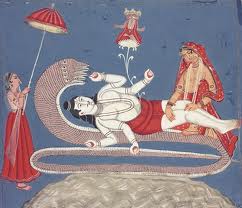 Vishnu’s serpent throne, or Vishnu himself, the one who sustains the whole universe. The universe is intelligence manifest. Life is intelligence manifest. When the human mind stops imposing and allows the feminine, the prana shakti, to emerge in her full glory, magic happens. Flowers bloom, birds sing, creativity flows. The postures are expressions of the infinite, not a preliminary stage on the way to somewhere else. But when we impose willfully, without deep sensitivity, confusion is sustained and we forget. It is a tricky balance, returning to a living dynamic balance from the habits of tension (rajas) and collapse (tamas), as our modern culture, highly dissociated from life, lives in a world of mind/abstraction disconnected from heart wisdom. The poses can be healing if we see how they bring us home, to our inherent wholeness.
Vishnu’s serpent throne, or Vishnu himself, the one who sustains the whole universe. The universe is intelligence manifest. Life is intelligence manifest. When the human mind stops imposing and allows the feminine, the prana shakti, to emerge in her full glory, magic happens. Flowers bloom, birds sing, creativity flows. The postures are expressions of the infinite, not a preliminary stage on the way to somewhere else. But when we impose willfully, without deep sensitivity, confusion is sustained and we forget. It is a tricky balance, returning to a living dynamic balance from the habits of tension (rajas) and collapse (tamas), as our modern culture, highly dissociated from life, lives in a world of mind/abstraction disconnected from heart wisdom. The poses can be healing if we see how they bring us home, to our inherent wholeness.
II- 48: tato dvandvaah anabhighaatah: Then (with the somatic aliveness of an awakened pose as expressed in the previous two sutras) the dvandvas resolve. Duality resolves. The non-dual wholeness of forms and the formless shines clearly. Purnamadah purnamidam. Many of the Patanjali Yoga Sutras, using the Sankhya metaphysical model, are dualistic in nature, but I – 3 and this one lay the non-dual right out for all to realize. Of course! Emaho!
Continuing the asana sequence from ‘Minneapolis Notes, part one‘, we come to one legged dog, as a continuation of ardha chandrasana. Lengthening the inner back leg from the core of body through the inner heel, simultaneously lengthen from the core through crown chakra to open chakra line from head to tail. Feel the grounding energy of the muladhara or root chakra trifurcating like Shiva’s trident, 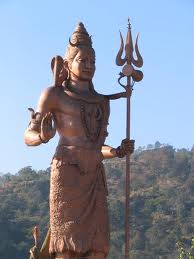 into the down leg, the up leg and your imaginary tail. This (muladhara extension) becomes the starting point for flipping the dog.
into the down leg, the up leg and your imaginary tail. This (muladhara extension) becomes the starting point for flipping the dog. 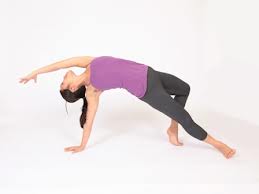 Extend in as many directions as possible, through arms and legs, elbows and knees, head and tail. This leads to using the back leg to come up into hand stand.
Extend in as many directions as possible, through arms and legs, elbows and knees, head and tail. This leads to using the back leg to come up into hand stand.  You can try from a front walk-over action to maximize the leg action, or start with hands on floor. Try to utilize the muladhara extension to get up, i.e., lead from your tail, not your head! There is a similar process for head balance in that the feet, legs and tail, the muladhara extension, lead the action.
You can try from a front walk-over action to maximize the leg action, or start with hands on floor. Try to utilize the muladhara extension to get up, i.e., lead from your tail, not your head! There is a similar process for head balance in that the feet, legs and tail, the muladhara extension, lead the action.
Back on the floor, a variation of parvrtta parsvakonasana I call the starfish, with the front foot and thigh turned out to 90 degrees (more than this gentleman) , allows another multi-vector exploration of
, allows another multi-vector exploration of
core and limbs. Experiment with differing angles of arms and degrees of torso rotation. Be playful and open. Don’t forget your tail.
Energy often gets stuck in the third chakra/diaphragm region and supported bridge pose is a wonderful way to help create space, width and length here.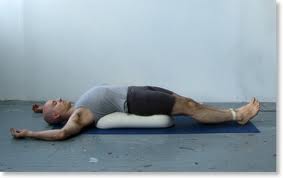
Classically, the pose is done with extended legs, but you can also bend the knees and keep the feet on the floor, or place the feet against the wall to engage the Deep Front Line from its roots in the soles of the feet. Trace the energy up through the pelvis into the diaphragm. Try to find the openings in the diaphragm for the aorta and esophagus passing downwards and the inferior vena cava traveling upwards. From these openings, widen the upper chest and relax the shoulders. Release through the throat and into the skull.
To further work on opening neck and throat, check out the action in uttana padasana. 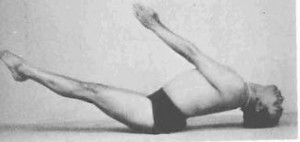 As the pubic bones roll into the floor lengthening the front line, feel the skull bone rotating in the opposite direction lengthening the throat. Dynamic arms and legs keep the back muscles from contracting and keep the action in the interior connective tissue structures. For an even more fun way to open the throat, repeat ‘wow’ again and again, feeling the expending and condensing of the mouth extending through the throat.
As the pubic bones roll into the floor lengthening the front line, feel the skull bone rotating in the opposite direction lengthening the throat. Dynamic arms and legs keep the back muscles from contracting and keep the action in the interior connective tissue structures. For an even more fun way to open the throat, repeat ‘wow’ again and again, feeling the expending and condensing of the mouth extending through the throat.
If you are now ready to be reborn, lie on the floor with your head touching a wall. Keep the knees bent and the feet on the floor. Awakening the DFL with a slight activation of the feet and trace the flow back through the pelvis, diaphragm, throat, through the soft palate, and out through the crown chakra gently pressing the wall. 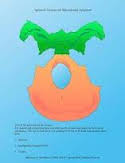 Find the sphenoid – basilar junction at the base of the skull and feel it breathing. Imagine the urge to emerge rippling through your cells as the udana vayu is activated and you re-experience some of the patterns of birthing.
Find the sphenoid – basilar junction at the base of the skull and feel it breathing. Imagine the urge to emerge rippling through your cells as the udana vayu is activated and you re-experience some of the patterns of birthing.
Chakra toning twist: Pick a seated twist of your choice, but before you decide which way to twist, ask your root chakra which way it wants to go, clock-wise or counter-clockwise. Set yourself up accordingly. Relax. As best you can, let the energy do the work. Try not to use the muscles. Let the energy turn the body until there is a natural pause. Invite the opposite rotation of the energy, like a pendulum reverses direction. Let the bones move as if they were floating in an eddy. Repeat. Let the first chakra drive the pose. At some point the two directions balance, the way a bouncing ball eventually settles down to the ground. Pause there, wherever the physical body may be.
Then, go to the sacral chakra, ask it which direction it prefers and let it turn. When it has completed its action invite the opposite. Repeat as above for each of the seven chakras. When complete, either rest in savasana, or do a short twist in the opposite direction from which you started. Usually, the first round balances all. Now rest in savasana! Feel the open spaciousness, be the open spaciousness. Tada drashtuh svarupe avasthaanam.!

